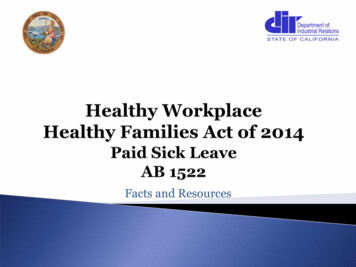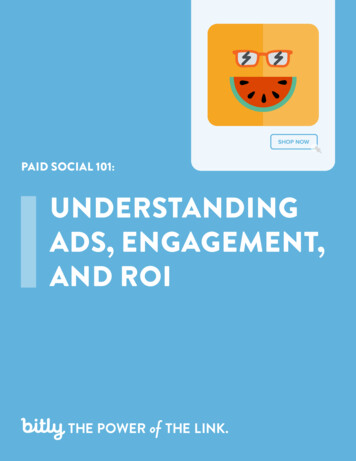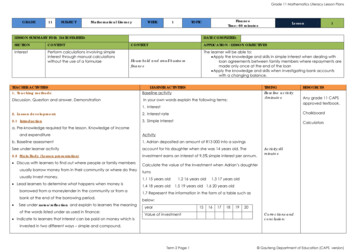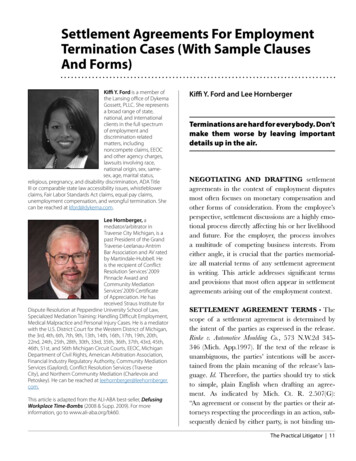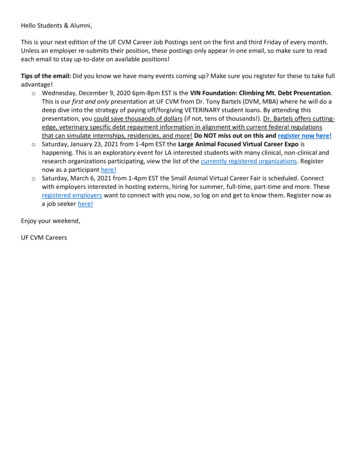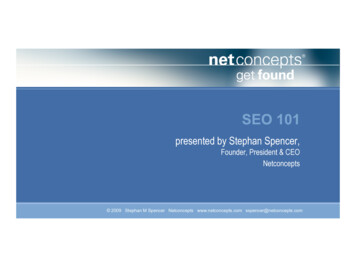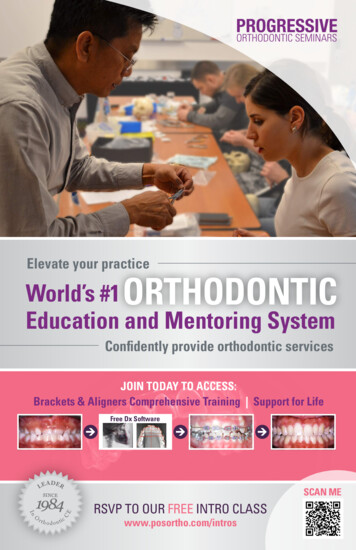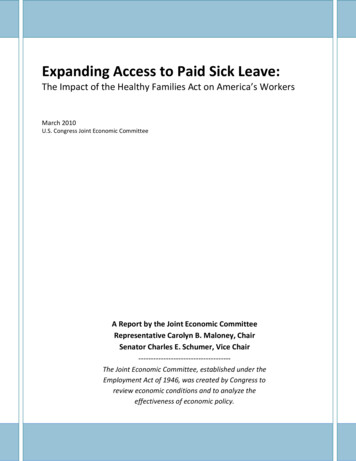
Transcription
Expanding Access to Paid Sick Leave:The Impact of the Healthy Families Act on America’s WorkersMarch 2010U.S. Congress Joint Economic CommitteeA Report by the Joint Economic CommitteeRepresentative Carolyn B. Maloney, ChairSenator Charles E. Schumer, Vice Chair------------------------------------The Joint Economic Committee, established under theEmployment Act of 1946, was created by Congress toreview economic conditions and to analyze theeffectiveness of economic policy.
Expanding Access to Paid Sick Leave: The Impact of the Healthy Families Act on America’s WorkersPage 1Executive SummaryPaid sick leave is a critical element of job security for American workers, yet forty percent ofemployees in the private sector today have no such leave. 1 For many workers, a day home sick –or day off of work to care for a sick child – means forgoing a paycheck. At a time when millionsof families are living paycheck to paycheck, the lack of paid sick leave forces sick employees togo to work and sick children to attend classes. Going to work sick or “presenteeism” is a publichealth issue, with sick workers spreading contagious disease to fellow co-workers andcustomers. The reduced productivity of workers who come to work sick and spillover impactson other employees is bad for businesses. 2 The provision of paid sick leave through the HealthyFamilies Act would dramatically expand access to paid sick leave, with salutary effects forsociety as a whole as well as the families for whom it would impact.This report represents the first estimates of the impact of the Healthy Families Act (S. 1152 andH.R. 2460) on access to paid sick leave. The bill would guarantee that workers in the UnitedStates at firms that employ at least 15 employees accrue at least one hour of paid sick leave forevery 30 hours worked.Using a combination of published and unpublished data from the Bureau of Labor Statistics, theJoint Economic Committee estimates:·As a result of the Healthy Families Act, at least 30.3 million additional workers wouldhave access to paid sick leave.3·The Healthy Families Act would significantly expand access to paid sick leave for many ofAmerica’s most vulnerable workers, including lower-wage workers, women, andminorities.4o Almost half of the increased access to paid sick leave (14.7 million additionalworkers) would accrue to workers in the bottom wage quartile.o Nearly half (13.3 million workers) of the increased access to paid sick leave wouldaccrue to women workers.o Almost one-third of the increased access to paid sick leave would accrue tominority workers, including 3.9 million additional African-American workers and5.6 million additional Latino workers.·The Healthy Families Act would also significantly expand access to paid sick leave forworkers in professions with critical public health implications. For instance, 5.9 millionadditional food service and preparation workers would have access to paid sick leavedue to the Healthy Families Act.5Prepared by the Majority Staff of the Joint Economic Committee
Expanding Access to Paid Sick Leave: The Impact of the Healthy Families Act on America’s WorkersPage 2IntroductionPaid sick leave is a critical element of job security and quality for American workers, yet fortypercent of private sector workers today have no such leave. 6 Paid sick leave not only givesworkers the opportunity to regain their health. Paid leave also allows employees to return towork fully productive, and helps stop the spread of disease to co-workers and customers. As aresult, paid sick leave can reduce employers’ overall costs while simultaneously contributing tothe health of the nation. The United States is amongst only a handful of nations that has nolegislation requiring paid sick leave for workers. 7 Voters agree that paid sick days are a criticalaspect of job quality. 86 percent of Americans favor a law that guarantees paid sick leave for allworkers.8The recession has hammered home the impossible choice a sick worker faces when forced todecide between a paycheck and his or her health. The weak labor market means that manyfamilies are living paycheck-to-paycheck, and simply cannot afford to forgo money or to puttheir job in jeopardy. Yet millions of workers are unable to miss work without forgoing apaycheck – or risking job loss. 17 percent of Americans report that they have lost a job or weretold they would lose their job if they took time off due to personal or family illness. 9Evidence suggests that employers have been rolling back sick leave coverage in recent years,particularly for low-wage workers who are already struggling to make ends meet. In New YorkCity, for instance, paid sick leave coverage for near-poor workers decreased from 56 percent in2007 to just 33 percent in 2009. 10 As a result, millions of employees go to work sick every day,exposing their colleagues and customers to illness and dragging down productivity. 68 percentof workers without paid sick leave have gone to work with symptoms of a contagious illnesssuch as the flu, compared to 53 percent of those with paid sick leave. 11 A worker who goes towork sick rather than staying home and resting may end up even sicker, eventually leading tolonger absenteeism from work.The H1N1 outbreak in the spring of 2009 further highlighted the problem with the status quo ofno federal policy around paid sick leave. The Centers for Disease Control and Prevention (CDC)recommended “social-distancing” as a strategy for prevention, asking workers with flu-likesymptoms to remain home and away from others until 24 hours after all symptoms haveresolved.12 Yet millions of workers face economic hardship if they heed the CDC’s advice,because remaining home means forgone wages. When Americans were asked about likelyproblems they would encounter with staying home for the standard course of the H1N1 virus,the most frequent answer (44 percent) was that they or a household member would “lose payand have money problems,” and 25 percent reported that they would be likely to lose their jobor business.13To make matters worse, workers in occupations with critical public health implications have verylow rates of access to paid leave. For instance, just 27 percent of food preparation and foodPrepared by the Majority Staff of the Joint Economic Committee
Page 3Expanding Access to Paid Sick Leave: The Impact of the Healthy Families Act on America’s Workersservice workers have access to paid sick leave. Similarly, just 27 percent of child care workershave access to paid sick leave.14 These workers are amongst America’s lowest-paid, with averageannual wages of around 20,000 – half the national average annual wage.15The Healthy Families Act (S. 1152 and H.R. 2460) would have a substantial impact on job qualityand job security for American workers. The Healthy Families Act would guarantee that workers inthe United States at firms that employ at least 15 employees accrue at least one hour of paid sickleave for every 30 hours worked. As a result of this legislation, at least 30.3 million additionalworkers would have access to paid sick leave. 16 The Healthy Families Act would significantlyexpand access to paid sick leave for many of America’s most vulnerable workers, including lowerwage workers, women, and minorities. The Healthy Families Act would also significantly expandaccess to paid sick leave for workers in professions with critical public health implications,including food services.Prepared by the Majority Staff of the Joint Economic Committee
Expanding Access to Paid Sick Leave: The Impact of the Healthy Families Act on America’s WorkersPage 4The Healthy Families Act Expands Paid Sick Leave Access for Private Sector WorkersThe Healthy Families Act would dramatically expand access to paid sick leave for private-sectorworkers. Currently, just 61 percent of the private-sector workforce (62.4 million workers) hasaccess to paid sick leave. This means that nearly 40 million private-sector workers do not haveaccess to paid sick leave today.17 30.3 million additional workers would receive coverage underthe Healthy Families Act, bringing coverage levels up to over 90 percent in the private-sectorworkforce.18Specifically, the Healthy Families Act would increase access to paid sick leave for all workers infirms with 15 or more employees. Today, just 64 percent (53.8 million) of those workers haveaccess to paid sick leave. The Healthy Families Act would guarantee that all workers in thosefirms had access to paid sick leave, adding coverage to 30.3 million new workers with the endresult that all 84.1 million Americans in firms with more than 15 employees would have accessto paid leave.19Figure 1. Over 30 Million Additional Workers Gain Accessto Paid Sick Leave Under the Healthy Families ActNewly Covered Under HFA 30.3 millionworkersCurrently Covered 53.8 millionworkersHFA increases paid sickleave access by 56%.Newly coveredworkers currentlycovered workers 84.1 millionAmericans withaccess to paid sickleave under HFASource: Joint Economic Committee calculations based on unpublished data from the Bureau of Labor Statistics 2009 National Compensation Survey.Note: All figures reflect paid sick leave access at establishments of 15 employees or more, because the Healthy Families Act would not impact coverage at smaller firms. As a result,current access to paid sick leave for the total population is larger than the figures here indicate.Prepared by the Majority Staff of the Joint Economic Committee
Page 5Expanding Access to Paid Sick Leave: The Impact of the Healthy Families Act on America’s WorkersThe Healthy Families Act Expands Access to Paid Sick Days for Lower-Wage WorkersLow-wage workers are far less likely than higher-wage workers to have access to paid sick leavetoday. Only 33 percent of workers in the bottom quartile of the wage distribution currently haveaccess to paid sick leave, compared to 81 percent of workers in the top quartile of the wagedistribution.20Today, just 35 percent (7.9 million) of workers in the bottom quartile in firms with 15 or moreemployees have access to paid sick leave. By expanding coverage to workers in these firms, theHealthy Families Act would cover 14.7 million new workers in the bottom wage quartile andresulting in a total of 22.6 million lower-wage workers with access to paid leave. Nearly half(48.6 percent) of all workers with new access to paid sick leave under the Healthy Families Actwould be amongst America’s lowest-paid.21Figure 2. 14.7 Million More Low-Wage Workers Will HaveAccess to Paid Sick Leave Under the Healthy Families ActCurrent QuartileBottomWageQuartileNew Access Under HFA22.1 million3.8 million workers covered18.3 million(20% increase)14.1 million13.6 million7.9 million4.7 million7.0 million18.8 millionworkers covered(33% increase)20.6 millionworkers covered(52% increase)14.7 million22.6 millionworkers covered(186% increase)Source: Joint Economic Committee calculations based on unpublished data from the Bureau of Labor Statistics 2009 National Compensation Survey.Note: All figures reflect paid sick leave access at establishments of 15 employees or more, because the Healthy Families Act would not impact coverage at smallerfirms. As a result, current access to paid sick leave for the total population is larger than the figures here indicate.Millions of these low-wage workers are employed in occupations with high levels ofinterpersonal contact, including child care, food service, and home health care. As a result oftheir occupations, these workers are at high risk of spreading disease if they report to work sick.Yet these workers are also likely to incur a serious financial hardship if they stay home. Inabsence of paid sick leave, low-wage workers face a choice between a much-needed paycheckand the health of themselves and their children. Moreover, poverty strongly correlates withpoor health in the United States.22 As a result, lower-wage workers may be at a greater risk ofillness than higher-wage workers, making access to paid sick leave particularly important forprecisely those workers with the lowest levels of current access.Prepared by the Majority Staff of the Joint Economic Committee
Expanding Access to Paid Sick Leave: The Impact of the Healthy Families Act on America’s WorkersPage 6The Healthy Families Act Expands Access to Paid Sick Days for WomenBecause the economic hardship associated with a day of unpaid leave is particularly acute forwomen, access to paid sick leave is of particularly importance for this group of workers. This isespecially true for female heads of household, who are solely responsible for their families’ wellbeing. Largely because of their sole-earner status, female headed households are amongst thenation’s poorest, with nearly 29 percent of female-headed households falling below the povertylevel.23Two-thirds (64.3 percent) of mothers work outside the home, and women’s earnings make up asubstantial share of family income.24 The typical working wife now brings home 42.2 percent ofher family’s earnings, which means that families are dependent on women’s earnings for theirfinancial well-being.25 While women’s work outside the home is of paramount importance,mothers still bear primary responsibility for a child’s health. 26 80 percent of mothers assumeprimary responsibility in the family for taking their children to doctor’s appointments. Half of allworking mothers must miss work if their child is sick, compared to 30 percent of workingfathers. And half of all working mothers who do stay home with children when they are sickreport that they do not get paid when they must do so. 27 Access to paid sick leave is thus ofparticular importance for working women because of the double burden they face – both selfcare and care for an ill child.Currently, more than a third (37 percent) of working women in establishments with more than15 employees lacks access to paid sick leave. The Healthy Families Act would expand access topaid sick days to an additional 13.3 million female workers in these firms, raising the number ofwomen with paid sick leave access to over 40.9 million. This represents a 48 percent increase inthe share of working women with access to paid sick leave. 28Figure 3. Over 13 Million Additional Working Women GainAccess to Paid Sick Leave Under the Healthy Families ActNewly-Covered Under HFA 13.3 millionworkersCurrently-Covered 27.6 millionworkersHFA increases paid sickleave access by 48% forworking women.Newly-coveredworkers currentlycovered workers 40.9 millionworking womenwith access to paidsick leave underHFASource: Joint Economic Committee calculations based on unpublished data from the Bureau of Labor Statistics 2009 National Compensation Survey and the March Current PopulationSurvey.Note: All figures reflect paid sick leave access at establishments of 15 employees or more, because the Healthy Families Act would not impact coverage at smaller firms. As a result,current access to paid sick leave for the total population is larger than the figures here indicate.Prepared by the Majority Staff of the Joint Economic Committee
Page 7Expanding Access to Paid Sick Leave: The Impact of the Healthy Families Act on America’s WorkersThe Healthy Families Act Expands Access to Paid Sick Days for MinoritiesMinority workers are amongst the nation’s most economically vulnerable. 57 percent of working-poor families have at least one non-white parent.29 Over a quarter of working-poor families (28percent) have at least one Latino parent, and one-fifth include at least one African-Americanparent.30 As a result, these workers are amongst those least able to give up a day’s pay inexchange for a day home sick, or home with a sick child.Yet African-American and Latino workers currently have limited access to paid sick leave. Inestablishments with 15 or more employees, nearly 40 percent of African-Americans have nopaid sick days. Similarly, nearly half (49 percent) of all Latino employees in businesses with morethan 15 employees have no access to paid sick leave. The Healthy Families Act wouldsubstantially expand access to paid sick leave for minority workers. Under the Act, paid sickleave for African-American workers in covered firms would expand by 60 percent, covering 3.9million additional African-American workers and resulting in a total of at least 10.5 millionAfrican-American workers with paid sick leave coverage. Paid sick leave for Latino workers incovered firms would expand by 78 percent, covering an additional 5.6 million Latino workersand resulting in a total of at least 12.8 million Latino workers with paid sick leave coverage. 31Figure 4. 3.9 Million More African-American and 5.6Million More Latino Workers Will Have Access to Paid SickLeave Under The Healthy Families ActCoverage for African-American workerswill expand by 60% under HFA.Coverage for Latino workers willexpand by over 78% under HFA.10.5 million black workers covered12.8 million Hispanic workers coveredNewAccess3.9 millionCurrentCoverage6.6 millionAfrican-AmericanNewAccess5.6 millionCurrentCoverage7.2 millionLatinoSource: Joint Economic Committee calculations based on unpublished data from the Bureau of Labor Statistics 2009 National Compensation Survey and the March Current PopulationSurvey.Note: All figures reflect paid sick leave access at establishments of 15 employees or more, because the Healthy Families Act would not impact coverage at smaller firms. As a result,Prepared by the Majority Staff of the Joint Economic Committee
Expanding Access to Paid Sick Leave: The Impact of the Healthy Families Act on America’s WorkersPage 8The Healthy Families Act Expands Access to Paid Sick Days for Occupations with Key PublicHealth ImplicationsMany common infectious diseases are transmitted in workplaces, particularly in workplaces withhigh degrees of direct contact with the public. For instance, food service workers prepare foodconsumed directly by the public. Child care workers surrounded by young children and parentsincur substantial interpersonal contact. Because of the enhanced danger of contagion foroccupations such as these, it is critical that sick employees stay home rather than come to workill.Moreover, many of those workers in occupations with critical public health implications areamongst America’s lowest-paid. Child care workers earn an average of 20,350 annually, whilefood preparation workers typically earn an average of 20,220 annually. 32 These figures are lessthan half the national average annual wage for all occupations, 42,270, which suggests thatworkers in these occupations are also amongst the nation’s most economically vulnerable andtherefore, amongst the least likely to be able to afford to forgo a day’s pay in order to recover athome and avoid spreading infectious illnesses.Figure 5. 6.0 Million More Food Service Workers and 1.4Despite the importance ofMillionMore Personal Care Workers Will Have Access toaccess to paid leave for thesePaid Sick Leave Under The Healthy Families Actcritical occupations, foodpreparation workers andCoverage for food service workers willCoverage for personal care workersexpand by 259% under HFA.will expand by over 107% under HFA.“personal care workers” are8.3 million food service workers covered2.7 million personal care workers coveredamongst the least likely tohave such benefits today.33Just 28 percent of child careworkers in establishments ofNew6.0 million15 or more employees have Accessaccess to paid sick leaveNewtoday. 48 percent of personal1.4 millionAccessCurrent2.3 millioncare workers in such CoverageCurrent1.3 millionCoverageestablishments have accessFood Preparation and ServicesPersonal Care and Servicesto paid sick leave today.34The Healthy Families Actwould substantially expandaccess to paid sick leave for workers in these occupations with critical public health implications.Under the Act, paid sick leave for food services workers in covered firms would expand by 259percent, covering 6.0 million additional food service workers and resulting in a total of at least8.2 million food service workers with paid sick leave coverage. Paid sick leave for personal careworkers in covered firms would expand by 107 percent, covering an additional 1.4 millionpersonal care workers and resulting in a total of at least 2.7 million personal care workers withpaid sick leave coverage.35Source: Joint Economic Committee calculations based on unpublished data from the Bureau of Labor Statistics 2009 National Compensation Survey and the March Current PopulationSurvey.Note: All figures reflect paid sick leave access at establishments of 15 employees or more, because the Healthy Families Act would not impact coverage at smaller firms. As a result,current access to paid sick leave for the total population is larger than the figures here indicate.Prepared by the Majority Staff of the Joint Economic Committee
Page 9Expanding Access to Paid Sick Leave: The Impact of the Healthy Families Act on America’s WorkersConclusionAmerican workers can ill-afford to choose between their health and a paycheck, particularly intoday’s economic climate. Yet the status quo requires the majority to do just that, as the lack offederal legislation mandating access to paid sick days means that millions of employees mustforgo their earnings if they are to stay home to care for their own health or that of a sick child.The status quo represents not only poor public health policy, as workers sick on the job andchildren ill at school contribute to the spread of contagious disease. It’s also poor economicpolicy, as sick workers create a drag on their own and co-workers’ productivity.The Healthy Families Act would insure that all workers in firms with 15 or more employees areable to earn paid sick leave, insuring a healthier and more productive America. As the analysisabove has detailed, the impact of the Healthy Families Act would be substantial for allAmericans, but it would be particularly beneficial for a number of especially vulnerable groupsof workers. Lower-wage workers, who are more likely to be unable to weather the blow of a daywithout pay, would benefit from this legislation. Female workers, who are both moreeconomically vulnerable than their average male counterparts and are more likely to beresponsible for their family’s health and well-being, would benefit. Minorities, who are morelikely to be in lower-wage jobs and therefore less likely to be able to go a day without pay,benefit from this legislation. And occupations with critical public health implications – includingthe low-paid fields of food service and personal care workers – would benefit immensely.Paid sick leave is a critical element for workers’ economic security. The dramatic expansion ofaccess to paid sick leave under the Healthy Families Act would play a critical role in ensuringthat families maintain stable economic footing in unsteady times.Prepared by the Majority Staff of the Joint Economic Committee
Document TitlePage 7.66 percent of all civilian workers in the United States have access to paid sick leave, according to the Bureau of LaborStatistics. Bureau of Labor Statistics. 2009. “Employee Benefits in the United States, March 2009.” Table 6. http://www.bls.gov/news.release/pdf/ebs2.pdf.For example, see Goetzel, Ron Z., Long, Stacey R., Ozminkowski, Ronald J., Hawkins, Kevin, Wang, Shaohung, and Lynch,Wendy. 2004. “Health, Absence, Disability, and Presenteeism Cost Estimates of Certain Physical and Mental HealthConditions Affecting U.S. Employers.” Journal of Occupational and Environmental Medicine. Lovell, Vicki. 2004. No Time toBe Sick: Why Everyone Suffers When Workers Don’t Have Paid Sick Leave. Washington, DC: Institute for Women’s PolicyResearch. Available at http://www.iwpr.org/pdf/B242.pdf. Stewart, W., Matousek, D., and Verdon, C. 2003. The AmericanProductivity Audit and the Campaign for Work and Health. The Center for Work and Health, Advance PCS.This analysis focuses on the impact of the Healthy Families Act on the private-sector workforce only. Private-sector workershave lower levels of access to paid sick leave than do public sector workers. For example, according to the Bureau of LaborStatistics, 89 percent of state and local government workers have access to paid sick leave as compared to just 61 percentof the private-sector workforce. The Healthy Families Act would apply to both the public and private sector, therefore theJoint Economic Committee’s estimates presented in the following analysis likely understate the full impact of the HealthyFamilies Act on access to paid sick leave. See Bureau of Labor Statistics. 2009. “Employee Benefits in the United States,March 2009.” Table 6. http://www.bls.gov/news.release/pdf/ebs2.pdf.Joint Economic Committee calculations based on unpublished data from the Bureau of Labor Statistics’ 2009 NationalCompensation Survey and the March 2009 Current Population Survey. Methods available from the Joint EconomicCommittee upon request.Joint Economic Committee calculations based on unpublished data from the Bureau of Labor Statistics’ 2009 NationalCompensation Survey.66 percent of all civilian workers in the United States have access to paid sick leave, according to the Bureau of LaborStatistics. Bureau of Labor Statistics. 2009. “Employee Benefits in the United States, March 2009.” Table 6. nn, Jody and Alison Earle. 2009. Raising the Global Floor: Dismantling the Myth That We Can’t Afford Good WorkingConditions for Everyone. Stanford, CA: Stanford Politics and Policy. See http://researchtoaction.mcgill.ca/public html/wfei/index.php.Smith, Tom W. 2008. “Paid Sick Days: A Basic Labor Standard for the 21st Century.” Chicago, IL: National Opinion ResearchCenter. , Tom W. 2008. “Paid Sick Days: A Basic Labor Standard for the 21st Century.” Chicago, IL: National Opinion ResearchCenter. , Jeremy and Nancy Rankin. 2009. “Sick in the City: What the Lack of Paid Leave Means for New Yorkers. An Analysis ofEight Years of Findings From The Unheard Third.” New York: Community Service Society/A Better Balance. n com docman&task doc view&gid 72&Itemid 99999999.Smith, Tom W. 2008. “Paid Sick Days: A Basic Labor Standard for the 21st Century.” Chicago, IL: National Opinion ResearchCenter. rs for Disease Control and Prevention. October 23, 2009. “CDC Recommendations for the Amount of Time Personswith Influenza-Like Illness Should Be Away from Others.” Blendon, Robert, G. Steel Fisher, J. Benson, K. Weldon, and M. Herrmann. 2009. “Influenza A (H1N1)/Swine Flu Survey a-a-h1n1-outbreakfall-winter.html.Unpublished data from the Bureau of Labor Statistics’ National Compensation Survey, March 2009.Bureau of Labor Statistics. 2008. “May 2008 National Occupational Employment and Wage Estimates.” http://www.bls.gov/oes/2008/may/oes nat.htm#b25-0000.This analysis focuses on the impact of the Healthy Families Act on the private-sector workforce only. Private-sector workershave lower levels of access to paid sick leave than do public sector workers. For example, according to the Bureau of LaborStatistics, 89 percent of state and local government workers have access to paid sick leave as compared to just 61 percentof the private-sector workforce. The Healthy Families Act would apply to both the public and private sector, therefore theJoint Economic Committee’s estimates presented in the following analysis likely understate the full impact of the HealthyFamilies Act on access to paid sick leave. See Bureau of Labor Statistics. 2009. “Employee Benefits in the United States,March 2009.” Table 6. nt access figures are from unpublished data provided by the Bureau of Labor Statistics National Compensation Survey.These figures are likely to overstate current access to leave because many employers impose a job tenure requirement onworkers prior to offering access to paid sick leave. As a result, the Joint Economic Committee’s estimate of the impact ofPrepared by the Majority Staff of the Joint Economic Committee
Expanding Access to Paid Sick Leave: The Impact of the Healthy Families Act on America’s Workers18.19.20.21.22.23.24.25.26.27.28.29.Page 11the Healthy Families Act is conservative, because the analysis may over-estimate access in the absence of the legislation.Specifically, the Bureau of Labor Statistics’ survey is unable to ascertain whether a given worker has met an employers’ jobtenure requirements, therefore many employers may actually overstate their workforce’s access to paid sick leave. Priorresearch has demonstrated that correcting for workers’ job tenure substantially lowers the share of Americans with accessto paid sick days relative to the raw data presented by the Bureau of Labor Statistics. See Lovell, Vicky. 2004. “No Time ToBe Sick: Why Everyone Suffers When Workers Don’t Have Paid Sick Leave.” Washington, DC: Institute for Women’s PolicyResearch. http://www.iwpr.org/pdf/B242.pdf. Unfortunately, due to data restrictions, a similar correction to the Bureau ofLabor Statistics most recent data is not possible. Thus the Joint Economic Committee estimates may overstate status-quoaccess to paid sick leave by relying on the uncorrected Bureau of Labor Statistics data.Joint Economic Committee calculations b
Page 3 Expanding Access to Paid Sick Leave: The Impact of the Healthy Families Act on America's Workers service workers have access to paid sick leave. Similarly, just 27 percent of child care workers have access to paid sick leave.14 These workers are amongst America's lowest-paid, with average annual wages of around 20,000 - half the national average annual wage.15
